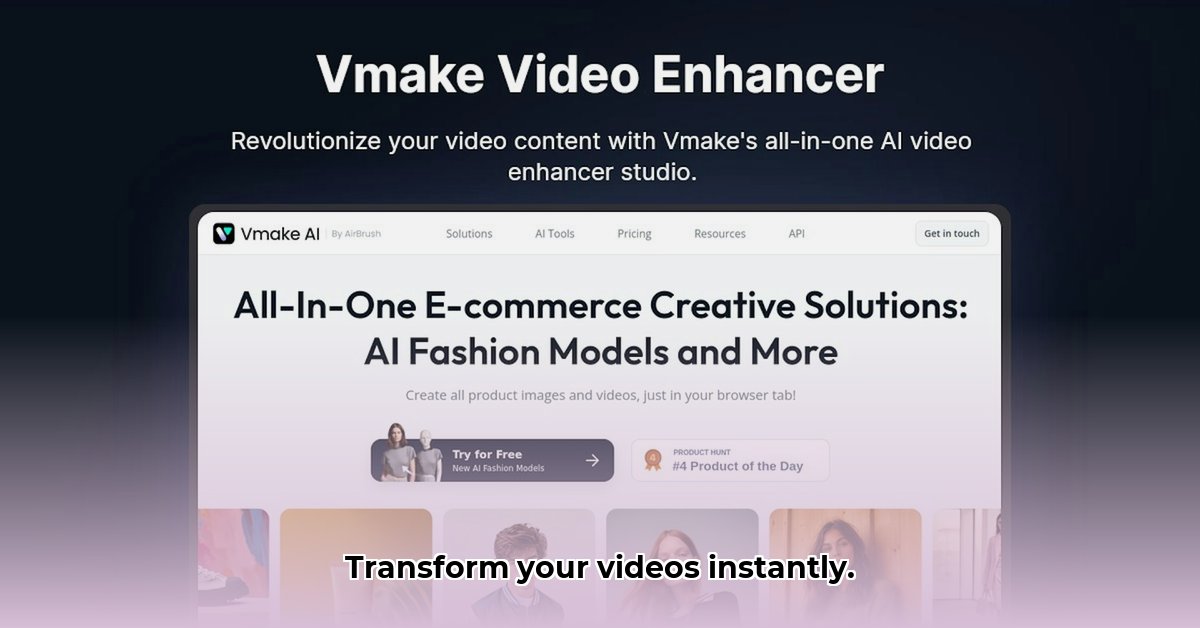
VMake AI Video Enhancer: A Deep Dive into AI-Powered Video Enhancement
Tired of dull, blurry videos? VMake AI Video Enhancer promises a Hollywood-level makeover for your footage, leveraging artificial intelligence to significantly improve video quality. But how does it work, and how does it stack up against the competition? This article delves into the technical aspects of VMake, explores its strengths and weaknesses, and examines the broader ethical considerations within the rapidly expanding AI video enhancement market.
VMake operates as a cloud-based service, requiring no account setup. Users simply upload their videos, and VMake's proprietary AI algorithms enhance the footage, sharpening images, boosting colors, and generally refining the overall visual appeal. The process is remarkably straightforward: upload, enhance, download. This ease of use makes it accessible to both casual users and seasoned video professionals. But what exactly is the AI doing?
While the precise details of VMake's algorithms remain undisclosed (likely to protect intellectual property), the AI appears to focus on several key aspects of video quality. It subtly adjusts parameters such as brightness, contrast, and sharpness. Think of it as a sophisticated digital retouch, subtly enhancing the vibrancy and clarity of your video. It even appears to automatically improve color saturation, making your videos visually arresting. Isn't it amazing how much AI technology can do these days?
One notable feature is VMake's batch processing capability, allowing for simultaneous enhancement of up to three videos. However, the company hasn't publicly released data on processing times or the computational resources used. Processing times are likely variable, depending on the size and complexity of the uploaded videos; larger, more intricate files may require longer processing.
VMake's Performance: A Balanced Perspective
Let's weigh the pros and cons:
| Feature | Pros | Cons |
|---|---|---|
| Ease of Use | Exceptionally user-friendly; no account required; supports batch processing (up to 3 videos). | Lacks advanced customization options; users largely relinquish control to the AI. |
| Speed | Generally fast processing, albeit dependent on video size and complexity. | Processing times not explicitly quantified; larger files may experience longer processing durations. |
| AI Algorithm | Produces noticeable improvements in video quality; enhances visual appeal. | Algorithm specifics and potential biases are not publicly disclosed. |
| Scalability | Handles multiple videos concurrently; however, maximum file size/resolution limits are unknown. | Scalability limits are undefined; very large or high-resolution videos might pose processing challenges. |
The Competitive Landscape and Ethical Considerations
VMake is not alone in the AI video enhancement arena. The market is experiencing explosive growth, with numerous companies developing similar tools. However, a lack of standardized testing and benchmarks hinders direct performance comparisons between different services. This absence of objective metrics makes proclaiming a single "best-in-class" solution premature.
Furthermore, the power of AI video enhancement raises vital ethical concerns. The potential for misuse, particularly in creating convincing deepfakes or manipulating evidence, cannot be ignored. This inherent risk necessitates robust guidelines regarding copyright, intellectual property, and the responsible use of this technology. The lack of clear regulatory frameworks in this rapidly evolving field is a cause for concern.
Navigating the AI Video Enhancement Market: A Comparative Framework
Choosing the right AI video enhancement service can be daunting. This section provides a structured approach to comparing different options:
Understanding Your Needs: Before selecting a service, define your priorities. Are you a professional filmmaker requiring top-tier results, or a casual user seeking quick, straightforward enhancements? Your budget is another critical factor, considering the varying pricing models (one-time purchases versus subscriptions).
Assessing AI Video Enhancement Tools: When comparing tools, focus on these key aspects:
- Upscaling: Evaluates the service's ability to increase resolution without introducing artifacts. Look for before-and-after comparisons of challenging source material.
- Noise Reduction: Measures the effectiveness of minimizing grain and other noise without sacrificing detail. Objective metrics, if available, are preferable to subjective visual assessments.
- Stabilization: Assesses the AI's ability to stabilize shaky footage while maintaining natural motion.
- Processing Speed and Efficiency: Determines how quickly the software processes videos, particularly high-resolution footage.
- Ease of Use and Integration: Evaluates the user-friendliness of the interface and its compatibility with existing editing software.
Comparative Analysis: A structured comparison requires the following steps:
- Identify Top Contenders: Select 2-3 AI video enhancers based on your needs and budget.
- Test with Identical Footage: Use the same video clip(s) to ensure a fair comparison.
- Assess Key Features: Evaluate each tool based on the criteria outlined above.
- Document Findings: Maintain detailed notes and screenshots for future reference.
- Consider Pricing: Weigh the cost against the quality and performance of each tool.
Remember that subjective impressions are equally valid. While objective metrics provide valuable data, your personal preferences regarding the aesthetic qualities of upscaling or noise reduction significantly influence the final decision. The future of this technology relies on addressing these ethical and practical considerations.
⭐⭐⭐⭐☆ (4.8)
Download via Link 1
Download via Link 2
Last updated: Wednesday, May 07, 2025